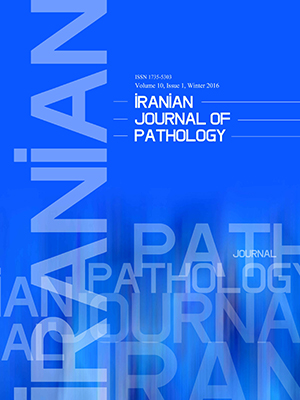Document Type : Original Research
Authors
- Gholamreza Irajian 1
- Mehri Sharifi 2
- Shiva Mirkalantari 3
- Reza Mirnejad 4
- Mohammad reza Jalali Nadoushan 5
1 Dept. of Microbiology, Iran University of Medical Science, Tehran, Iran
2 Dept. of Microbiology, Islamic Azad University, Zanjan Branch, Zanjan, Iran
3 Dept. of Microbiology, Semnan University of Medical Sciences, Semnan, Iran
4 Molecular Biology Research Center, Baqiyatallah University of Medical Sciences, Tehran, Iran
5 Dept. of Pathology, School of Medicine, Shahed University, Tehran, Iran
Abstract
Background: In most cases, prostatitis can be caused by a bacterial agent such as Ureaplasma urealyticum. Considering to the cumbersome of the culture method for the detection of Ureaplasma species in clinical samples such as prostate; PCR method that is faster and more appropriate than the cultivation methods, can be utilized for the detection of U. urealyticum and U. parvum. PCR-RFLP method can differentiate both biovars and assist in studies of the clinical diagnosis, epidemiology and pathology of this species in human. The aim of this study was to molecular detection of U. urealyticumin in prostate tissue samples based on PCR- RFLP. Methods:Two hundred prostate tissue samples were collected from patient suffering from prostatitis. The PCR assay was used to amplify a 559 bp fragment of 16S-23SRNA interspace region of Ureaplasma. After sequencing, PCR products from positive samples were digested with TaqI restriction enzyme.
Results: Seven cases (3.5%) out of 200 prostate tissue samples were positive for U. urealyticum. Results of PCR products sequencing demonstrated that all isolates were U. parvum biovar. PCR-RFLP results shown that there was not any differentiation in pattern of enzymatic digestion, in addition, all isolates were U. parvum, serovar 3.
Conclusion: U. urealyticum can be one of the causing agents of prostatitis. Using PCR-RFLP with specific primer and restriction enzyme is a rapid and cost-effect method for detection and differentiation of Ureaplasma from clinical samples.
Keywords
Main Subjects
- Domingue G, Hellstrom WP. Prostatistis. Clinical Microbiology Reviewes 1998;604-13.
- Škerk V. Azithromycin in the treatment of chronic bacterial prostatitis caused by traditional and unusual pathogens. 20th Europea Congress of Clinical Microbiology and Infectious Diseases 2010.
- Brunner H, Weidner W, Schiefer HG. Studies on the role of Ureaplasma urealyticum and Mycoplasma hominis in prostatitis. J Infect Dis 1983;147(5):807-13.
- Domingues D, Tavira LT, Duarte A, Sanca A, Prieto E, Exposto F. Ureaplasma urealyticum Biovar Determination in Women Attending a Family Planning Clinic in Guiné-Bissau, Using Polymerase Chain Reaction of the Multiple-Banded Antigen Gene. J Clin Lab Anal 2002;16:71-5.
- Yi J, Yoon B, Kim EC. Detection and biovar discrimination of Ureaplasmaurealyticum by real-time PCR. Mol Cell Probes 2005; 19(4):225-60.
- Pitcher D, Sillis M, Robertson J. Simple Method for Determining Biovar and Serovar Types of Ureaplasma urealyticum Clinical Isolates Using PCR–Single-Strand Conformation Polymorphism Analysis. J Clin Microbiol 2002; l39(5):1840-4.
- Stellrecht KA, WoronAM, Mishrik NG, Venezia RA. Comparison of multiplex PCR assay with culture detection of genital mycoplasmas. J Clin Microbiol 2004; 42:1528-33.
- Farrell JJ, Larson JA, Akeson JW, Lowery KS, Rounds MA, Sampath R, et al.Ureaplasmaparvum prosthetic joint infection detected by PCR. J Clin Microbiol 2014; 52:2248-50.
- Petrikkos G, Hadjisoteriou M, Daikos G. PCR versus culture in the detection of vaginal Ureaplasmaurealyticum and Mycoplasma hominis. Int J Gynecol Obstetr 2007;97(3):202-3.
- Ota M, Asamura H, Oki T, Sada M. Restriction enzyme analysis of PCR products. Methods Mol Biol 2009; 578:405-14.
- Rasmussen H. Restriction Fragment Length Polymorphism Analysis of PCR-Amplified Fragments (PCR-RFLP) and Gel Electrophoresis – Valuable Tool for Genotyping and Genetic Fingerprinting In: Magdeldin, editor. Principles and Basics. InTech Publication. 2012.
- Harasawa R, Kanamoto Y. Differentiation of two biovars of Ureaplasma urealyticum based on the 16S-23S rRNA intergenic spacer region. J Clin Microbiol 1999; 37(12):4135-8.
- Eslami G, Goudarzi H, Baseri N, Ghalavand Z, Taherpour A, Zhaam H, et al. The Prevalence of Ureaplasma Urealyticum and Mycoplasma Genitalium in Patients with Prostate Cancer in Shohada Hospital in Tehran, Iran. NBM 2015; 2: 73-8
- Viscardi R. Ureaplasma species: Role in Diseases of Prematurity. Clin Perinatol 2010; 37(2):393-409.
- Choi YS, Kim KS, Choi SW, Kim S,Bae WJ, Cho HJ, et al. Microbiological etiology of bacterial prostatistis in general hospital and primary care clinic in korea. Prostate Int 2013; 1(3):133-8.
- Vaidyanathan R, Mishra V. Chronic Prostatitis: Current Concept. Indian J Urol 2008; 24(1):22-7.
- Naher HS, Said IH. Culturing and PCR Methods for Detection of Mycoplasma hominis and Ureaplasma urealyticum in Women with Genitourinary Tract Infections. Int Res J Med Sci 2013;1(3):25-9.
- Waites KB, Xiao L, ParalanovV, Viscardi RM, Glass JI. Molecular methods for the detection of Mycoplasma and Ureaplasma infection in humans. J Mol Diagn 2012; 14(5):437-50.
- Lee MK, Kim TH, Lee M. Detection of Cryptic Microorganisms in Patients with Chronic Prostatitis by Multiplex Polymerase Chain Reaction. Korean J Urol 2007;48(3):304-9. doi: 10.4111/kju.2007.48.3.304.
- Lee SR, Chung JM, Kim YJ. Rapid one step detection of pathogenic bacteria in urine with sexually transmitted disease (STD) and prostatitis patient by multiplex PCR assay (mPCR). J Microbiol 2007; 45(5):453-9.
- Kong F, Zhenfang MA, James G, Gordon S,Gilbert GL. Species Identification and Subtyping of Ureaplasma parvum and Ureaplasma urealyticum Using PCR-Based Assays. J Clin Microbiol 2000;38(3):1175-79.
- Povlsen K, Jensen JS, Lind I. Detection of Ureaplasma urealyticum by PCR and Biovar Determination by Liquid Hybridization. J Clin Microbiol 1998;36(11):3211-216.
- Mander R, Raukas E, Turk S, Korrovits P, Punab M. Mycoplasmas in semen of chronic prostatistis patients. Scand J Urol Nephrol 2005;39(6):479-82.

